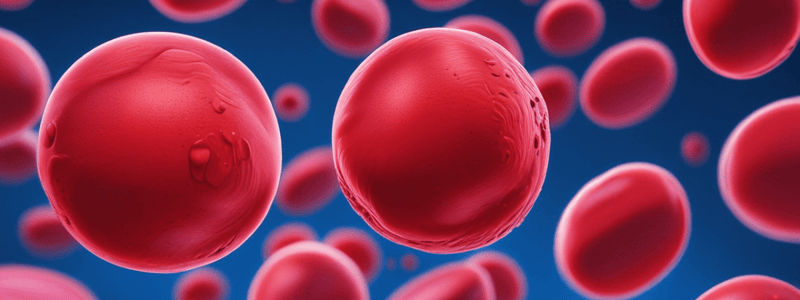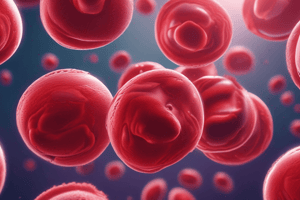Podcast
Questions and Answers
What is the main function of red blood cells (RBCs)?
What is the main function of red blood cells (RBCs)?
- To transport carbon dioxide from the tissues to the lungs for exhalation
- To measure the hematocrit and hemoglobin levels in the blood
- To give blood its distinctive color
- To transport oxygen from the lungs to the tissues of the body (correct)
What is the process by which oxygen is transported in the red blood cells?
What is the process by which oxygen is transported in the red blood cells?
- Oxygen is directly dissolved in the plasma of the blood
- Oxygen is transported through the cell membrane of the RBCs
- Oxygen binds to the protein hemoglobin in the RBCs (correct)
- Oxygen is carried by the platelets in the blood
What is the average lifespan of a red blood cell?
What is the average lifespan of a red blood cell?
- 90 days
- 60 days
- 30 days
- 120 days (correct)
What is the process by which red blood cells are produced in the body?
What is the process by which red blood cells are produced in the body?
What is the approximate number of red blood cells produced in the bone marrow each second?
What is the approximate number of red blood cells produced in the bone marrow each second?
What is the percentage of the cellular portion of whole blood that red blood cells (RBCs) account for?
What is the percentage of the cellular portion of whole blood that red blood cells (RBCs) account for?
What is the purpose of a complete blood cell count (CBC) in relation to red blood cells?
What is the purpose of a complete blood cell count (CBC) in relation to red blood cells?
Which of the following is NOT an indication for the transfusion of red blood cells (RBCs)?
Which of the following is NOT an indication for the transfusion of red blood cells (RBCs)?
What is the purpose of removing the plasma from the transfused material when giving a red blood cell (RBC) transfusion?
What is the purpose of removing the plasma from the transfused material when giving a red blood cell (RBC) transfusion?
What is the term used to describe the RBCs after the plasma has been removed during the transfusion process?
What is the term used to describe the RBCs after the plasma has been removed during the transfusion process?
What is the typical increase in hemoglobin level after a transfusion of a unit of PRBCs?
What is the typical increase in hemoglobin level after a transfusion of a unit of PRBCs?
At what hemoglobin level are transfusions of PRBCs usually administered?
At what hemoglobin level are transfusions of PRBCs usually administered?
What is the process called to obtain granulocytes, a component of whole blood?
What is the process called to obtain granulocytes, a component of whole blood?
What is typically administered instead of transfusing granulocytes?
What is typically administered instead of transfusing granulocytes?
What percentage of whole blood is the liquid portion called plasma?
What percentage of whole blood is the liquid portion called plasma?
What is the primary function of plasma in the body?
What is the primary function of plasma in the body?
Which of the following is a derivative of plasma that can be transfused?
Which of the following is a derivative of plasma that can be transfused?
What is the purpose of treating plasma derivatives with solvent detergent and heating?
What is the purpose of treating plasma derivatives with solvent detergent and heating?
What condition can be treated with transfusions of cryoprecipitate derived from plasma?
What condition can be treated with transfusions of cryoprecipitate derived from plasma?
What is the maximum storage time for fresh frozen plasma?
What is the maximum storage time for fresh frozen plasma?
Flashcards are hidden until you start studying




